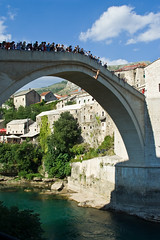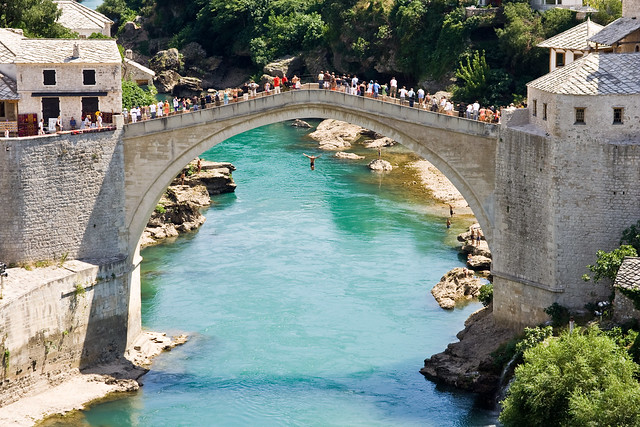Where to go in Bosnia and Herzegovina
Places I saw and recommend in Bosnia and Herzegovina: Sarajevo, Mostar, and the southern mountains around Herzegovina.
The opening of the Bosnia and Herzegovina chapter in The Hidden Europe
Bosnia and Herzegovina is Europe's most complicated country. That's ironic, because it's filled with Europe's simplest people.
Just how complicated is it? Try to understand this: Bosnia and Herzegovina is a bit smaller than West Virginia, but has three religions, three ethnic groups, yet one language (some claim that there are three languages). However, the country is not divided in three regions, but in two. Yet the exact definition of those two regions depends on what you're talking about. The two-way split can either be between the Bosnia region and the Herzegovina region or between the Republika Srpska and the Federation of Bosnia and Herzegovina. Oh, but then there's the tiny autonomous Brčko District, which you might call a third region. The three ethnic groups elect a President for a four-year term; each President controls the country for an eight-month period before handing power over to one of the other two Presidents. They rotate among themselves six times. On the other hand, none of that matters because there's this third guy, a foreigner called the High Representative, who has king-like powers.
Nothing is simple in the Balkans. — David Owen, author of two failed peace attempts during the Bosnian War
To make this chapter simple, let's begin with some definitions. Bosnia and Herzegovina adopted its long name in 1326, when Bosnia conquered Herzegovina. Although it's unclear where Bosnia got its name, Herzegovina got its name from Herceg (Duke) Stjepan Vukčić. He humbly named his territory after himself, so that Herzegovina means Dukeland. Today, Herzegovina, which is in the country's mountainous southern corner, is a quarter of the size of Bosnia. Therefore, for simplicity, we'll just call the country Bosnia.
Next, let's define some demographic terms. Just like there are Mexican Americans (Americans with Mexican ethnicity), there are Bosnian Serbs. However, the Balkans reverses the way Americans use the term. The first word indicates where the passport comes from and the second word indicates the ethnicity. Hence, a Bosnian Serb is an ethnic Serb with Bosnian citizenship and a Bosnian Croatian is ethnic Croatian with Bosnian citizenship. Remember these terms or else you'll get confused. What's the difference between a Bosnian Serb and a Bosnian Croatian? Practically nothing, but don't tell them that.

 The three main groups in Bosnia are often said to be Serb, Croatian, and Muslim. However, that classification lacks parallelism. The last term is a religious identification, whereas the first two are not. So instead of Muslim, we'll call the third group Bosniak. Thus, the four million Bosnians come in three flavors: Bosniak (48% of the population), Serb (37%), and Croatian (14%). Genetically, they're basically identical.
The three main groups in Bosnia are often said to be Serb, Croatian, and Muslim. However, that classification lacks parallelism. The last term is a religious identification, whereas the first two are not. So instead of Muslim, we'll call the third group Bosniak. Thus, the four million Bosnians come in three flavors: Bosniak (48% of the population), Serb (37%), and Croatian (14%). Genetically, they're basically identical.
Since these three groups look the same, talk the same, and smell the same, the only notable difference between them is their religious affiliation. Generally speaking, Bosniaks are Muslims, Serbs are Orthodox Christians, and Croatians are Catholics. However, as we'll soon see, few Bosnians are truly religious, which is why they're effectively one people. It's just that in the last 20 years they've been pretending that they're not.
This is an excerpt of The Hidden Europe: What Eastern Europeans Can Teach Us. It's how the chapter on Bosnia begins. You might want to read my first impressions of Sarajevo when I visited in 2004.
Recommended reading
Read up about Bosnia and Herzegovina in Wikipedia and Bosnia in the CIA Factbook.
Travel deals to Bosnia
Check my favorite travel sites:
Interactive map of Bosnia
View Larger Map




